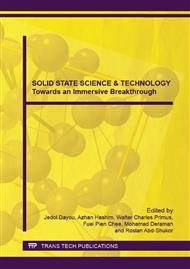[1]
N. Kerkouri, M. Haddad, M. Et-Tabirou, A. Chahine, L. Laanab. FTIR, Raman, EPR and optical absorption spectral studies on V2O5-dopedcadmium phosphate glasses. Physica B406 (2011) 3142-3148.
DOI: 10.1016/j.physb.2011.04.057
Google Scholar
[2]
Y. M. Lai, X. F. Liang, S. Y. Yang, J. X. Wang, L. H. Cao, B. Dai. Raman and FTIR spectra of iron phosphate glasses containing cerium. Journal of Molecule Structure 992 (2011)84-88.
DOI: 10.1016/j.molstruc.2011.02.049
Google Scholar
[3]
K. Srinivasulu, I. Omkaram, H. Obeid, A.S. Kumar,J. L. Rao. Structural and magnetic properties of Gd3+ ions in sodium-lead borophosphate glasses. Journal of Molecular Structure 1036 (2013)63-70.
DOI: 10.1016/j.molstruc.2012.09.041
Google Scholar
[4]
F.H. Elbatal, S. Ibrahim, A. M. Abdelghany. Optical and FITR spectra of NdF3-doped borophosphate glasses and effect of gamma irradiation. Journal of Molecular Structure (2012) 107-112.
DOI: 10.1016/j.molstruc.2012.02.049
Google Scholar
[5]
S. Rada, M. Culea, E. Culea. Structure of TeO2. B2O3 glasses infrared from infrared spectroscopy and DFT calculation. Journal Non Crystalline Solid (2008) 5491-5495.
DOI: 10.1016/j.jnoncrysol.2008.09.009
Google Scholar
[6]
G. R. Dillip,K. Mallikarjuna S.J. Dhoble,B. Dewa PrasadRaju. The luminescence and structural characteristics of Eu3+-doped NaSrB5O9 phosphor. Journal of Physics and Chemistry of Solids 75(2014)8–14.
DOI: 10.1016/j.jpcs.2013.07.008
Google Scholar
[7]
P. Pascutaa, S. Radaa, G. Borodi, M. Boscaa, L. Popa, E, Culeaa. Influence of europium ions on structure and crystallization properties of bismuth-alumino-borate glasses and glass ceramics. Journal of Molecular Structure 924–926 (2009) 214–220.
DOI: 10.1016/j.molstruc.2009.01.003
Google Scholar
[8]
S. Rada, P. Pascuta, M. Culea. The local structure of europium–lead-borate glass ceramics. Journal Non Crystalline Solid (2009) 89-92.
DOI: 10.1016/j.molstruc.2008.12.032
Google Scholar
[9]
A M. Babu, B. C. Jamalaiah, T. Suhasini, R. T. Srinivasa, R.L. Moorthy. Optical properties of Eu3+ ions in lead tungstate tellurite glasses. Solid State Science 13 (2011) 574-578.
DOI: 10.1016/j.solidstatesciences.2010.12.028
Google Scholar
[10]
F. Kang, Y. Hu, L. Cheng, X. Wang, Z. Mu, H. Wu. Eu3+ doped CAWO4-A potential red long afterglow phosphor. Applied Physics B 107(2012) 833-837.
DOI: 10.1007/s00340-012-4957-1
Google Scholar
[11]
K. R. Vernasevana, S. Sailaja,C. R. Nageswara,B. R. Sudhakar. Synthesis, the effect of rare earth ion concentration and temperature on luminescence properties of Eu3+: Ba3Y2WO9 ceramics. Journal of Luminescence 131 (2013) 1438-1442.
DOI: 10.1016/j.jlumin.2011.03.027
Google Scholar
[12]
V. R. Bandi, B. K. Grandhe, H. Woo, K. Jang, D. Shin, S. Yi, J. Jeong. Luminescence and energy transfer of Eu3+ or/and Dy3+ co-doped in Sr3AlO4Fphosphors with NUV excitation for WLEDs. Journal Alloy and Compounds 538(2012)85-90.
DOI: 10.1016/j.jallcom.2012.05.057
Google Scholar
[13]
K. Lingana, C. Srinivasa, C.K. Jayasankar. Optical properties and generation of white light in Dy3+ -doped lead phosphate glasses. Journal of Quantitative Spectroscopy& Radiative Transfer 118 (2013) 40-48.
DOI: 10.1016/j.jqsrt.2012.12.002
Google Scholar
[14]
E. Pavitra, R.R.G. Seta, S.Y. Jae. White light emission from Eu3+ co-activated Ca2Gd8Si6O26: Dy3+ nanophosphors by solvothermal synthesis. Ceramic International 39 (2013) 6319-6324.
DOI: 10.1016/j.ceramint.2013.01.057
Google Scholar
[15]
L.L. Martin, P. Haro-González, I.R. Martín. Optical properties of transparent Dy3+ doped Ba2TiSi2O8 glass ceramic. Optical Materials 33 (2011) 738–74.
DOI: 10.1016/j.optmat.2010.11.027
Google Scholar
[16]
C.N. Krishna, R. Jayavel. Wet chemical synthesis and characterization of pure and cerium doped Dy2O3 nanoparticles. Journal Physics and Chemistry of Solid73 (2012) 1164-1169.
DOI: 10.1016/j.jpcs.2012.05.009
Google Scholar
[17]
D. Subrata, R. A. Amaranth, P.G. Vijaya. Near white light emission from K+ ion compensated CaSO4: Dy3+, Eu3+ phosphors. Ceramics International 38 (2012) 5769-5773.
DOI: 10.1016/j.ceramint.2012.04.023
Google Scholar


